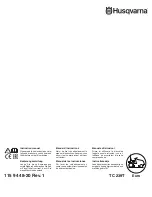
5 OPERATION
GB-12
5.6
TO DRIVE / TRANSPORT____________________________________________________
Read and follow all safety notes contained in this manual
when driving or transporting tractor. Refer to Section 5.3
for general operating instructions. When operating in
reverse look behind you to ensure you have a clear path.
Important: If this tractor is driven on public roads, it must
comply with federal, state and local ordinances. Contact
local authorities for regulations and equipment
requirements.
1.
Disengage all drives and raise implements to the
transport position when driving to and from the area
of operation.
2.
Disengage parking brake and move traction lever to
“TRANSPORT”. Depress accelerator pedal slowly.
5.7 TOWING / TRAILERING _____________________________________________________
If the tractor experiences problems and must be shut
down and removed from the area, it should be loaded
onto a trailer for transport. If a trailer is not available, the
unit can be towed slowly short distances.
NOTE: Do not exceed 2 MPH (3.2 KPH) while towing.
Long distance towing is not recommended.
Use care when loading and unloading tractor. Fasten
tractor to trailer to prevent tractor from rolling or shifting
during transport.
Before towing, raise cutting units. If cutting units cannot
be raised, remove them from the tractor.
Turn ignition switch OFF and remove key.
Make sure unit will not roll and release parking brake.
Engage parking brake after towing.
5.8
HILLSIDE OPERATION _____________________________________________________
The tractor has been designed for good traction and
stability under normal mowing conditions; however, use
caution when operating on slopes, especially over rough
terrain or when the grass is wet. Wet grass reduces
traction and steering control.
1.
Always mow with the engine at full throttle but reduce
forward speed to maintain the proper cutting
frequency.
2.
If the tractor tends to slide or the tires begin to
“mark” the turf, angle tractor into a less steep grade
until traction is regained or tire marking stops.
3.
If tractor continues to slide or mark the turf, the
grade is too steep for safe operation. Do not make
another attempt to climb, back down slowly.
4.
When descending a steep slope, always lower
implements to the ground to reduce the risk of
tractor overturning.
Correct tire pressure is essential for maximum traction.
CAUTION
To prevent tipping or loss of control, travel at reduced
speed when making turns.
!
WARNING
To minimize the possibility of overturning, the safest
method for operating on hills and terraces is to travel
up and down the face of the slope (vertically), not
across the face (horizontally). Avoid unnecessary
turns, travel at reduced speeds, stay alert for hidden
hazards, and drop offs.
CAUTION
Do not operate this tractor on slopes greater than
12.5°.
!
!
!













































